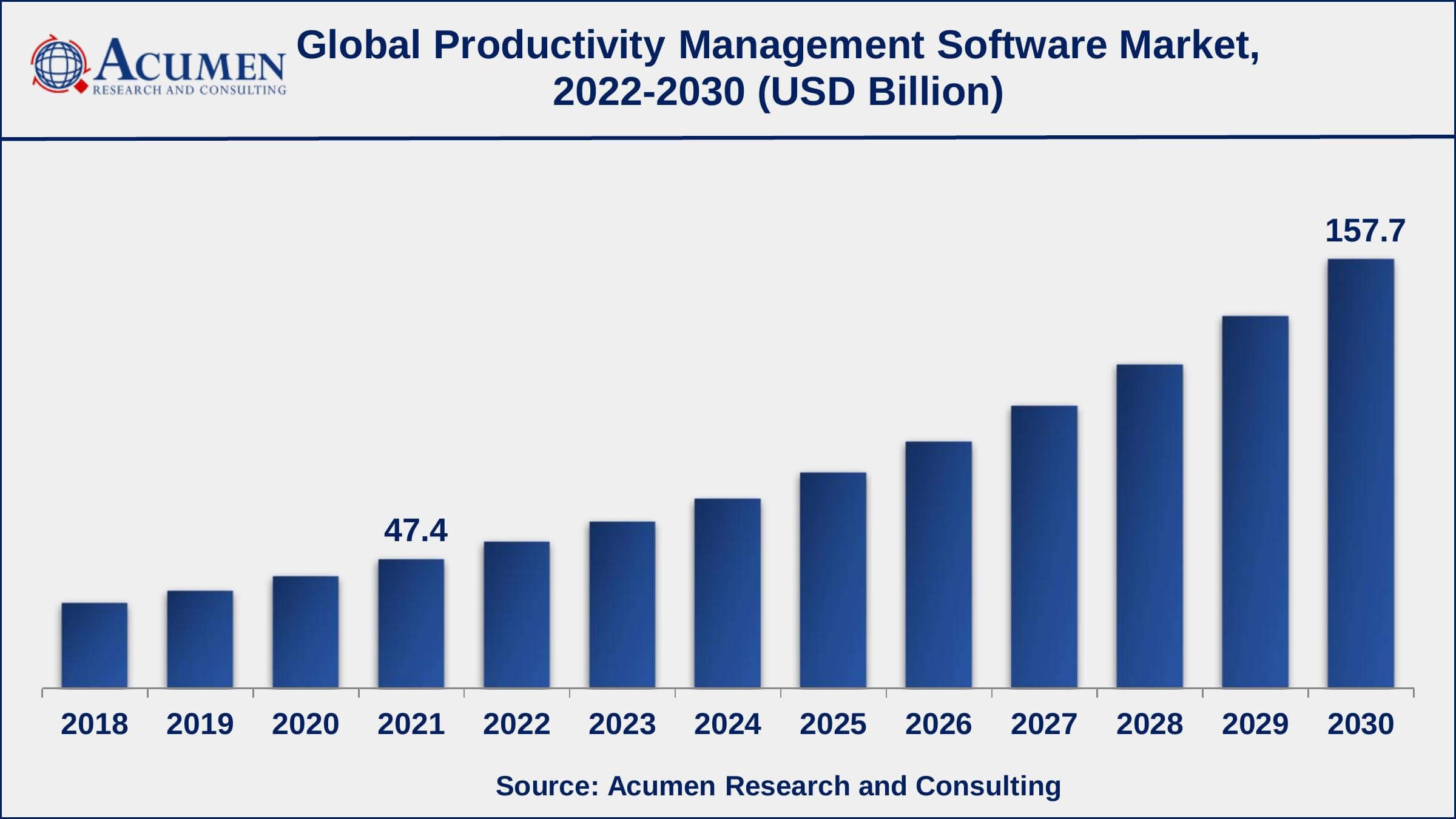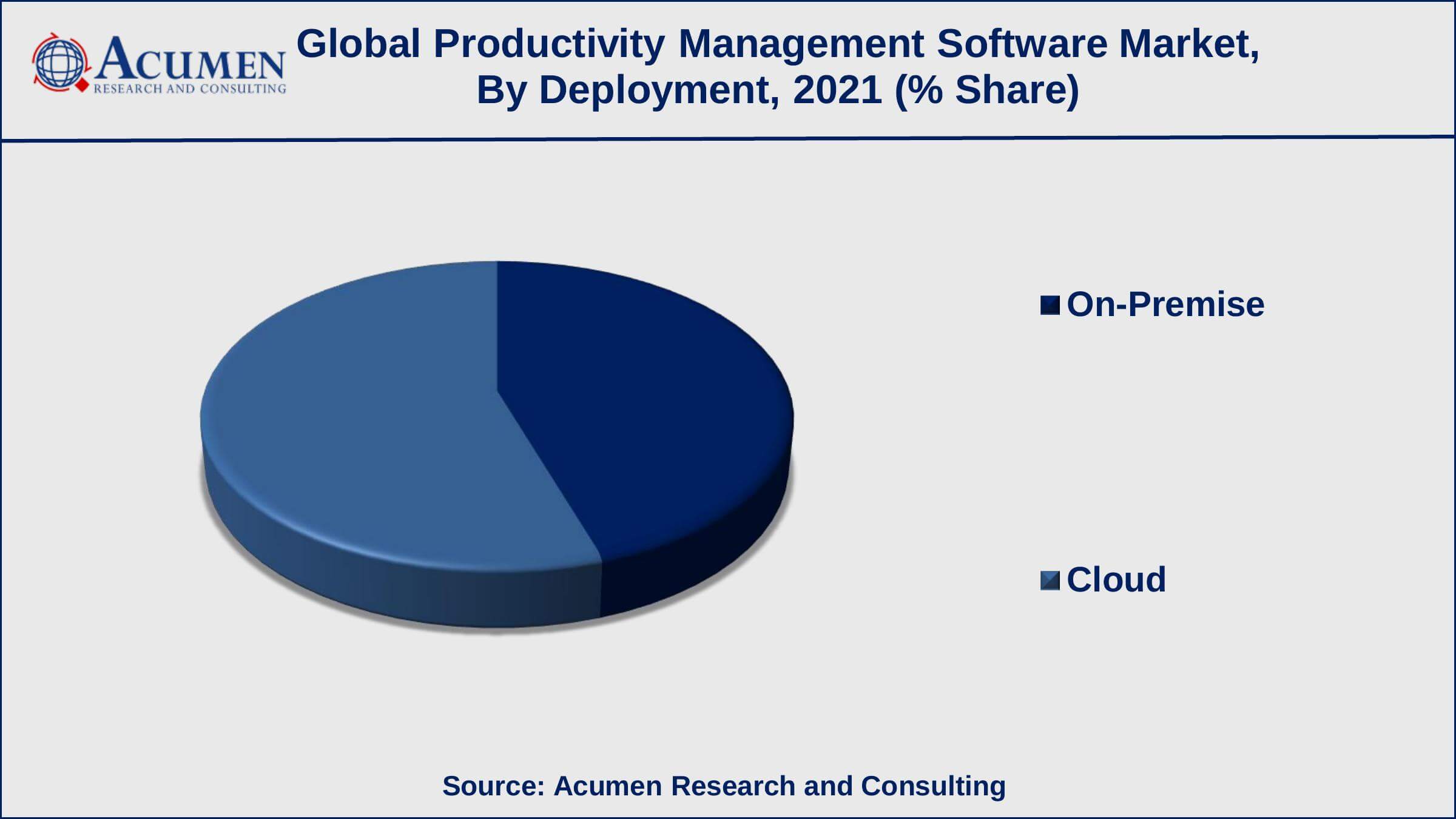Productivity Management Software Market Size - Global Industry, Share, Analysis, Trends and Forecast 2022 - 2030
Published :
Report ID:
Pages :
Format :
Productivity Management Software Market Size - Global Industry, Share, Analysis, Trends and Forecast 2022 - 2030
Report Coverage
- Industry Dynamics
- Market Size and Forecast Data
- Segment Analysis
- Competitive Landscape
- Regional Analysis with a Niche Focus on Country-Level Data
- High Level Analysis - Porter's, PESTEL, Value Chain, etc.
- Company Profiles of Key Players
- Option to Customize the Report As Per Your Specific Need
Request Sample Report
The Global Productivity Management Software Market Size valued for USD 47.4 Billion in 2021 and is projected to occupy a market size of USD 157.7 Billion by 2030 growing at a CAGR of 14.4% from 2022 to 2030.
Productivity management software (PMS) is a collection of advanced application platforms that assist businesses in the creation of documents, spreadsheets, databases, and presentations. Productivity management software, as the name implies, assists in increasing employee productivity, thereby growing an organization's business. While productivity software was originally designed for business use, it is now widely used for personal productivity as well. As a result, several companies are investing in R&D to create productivity management software solutions that are easy to implement and understand, as well as to increase workplace productivity.

Productivity Management Software Market Report Statistics
- Global productivity management software market revenue is projected to reach USD 157.7 Billion by 2030 with a CAGR of 14.4% from 2022 to 2030
- North America productivity management software market share gathered more than USD 17.1 billion in 2021
- Asia-Pacific productivity management software market growth will record a significant CAGR from 2022 to 2030
- Based on the solution, the content management and collaboration sub-segment achieved 35% shares in 2021
- Among deployment, the cloud-based sub-segment occupied around 54% of shares in 2021
- Increasing adoption of BYOD is a prominent productivity management software market trend that drives the industry demand

Global Productivity Management Software (PMS) Market Dynamics
Market Drivers
- Growing necessity to manage tasks and workflows
- Increasing implementation of AI and ML
- Rising demand for centrally managed productivity
Market Restraints
- Lack of awareness regarding new software technologies
- High cost of PMS
Market Opportunities
- Increased penetration of smart devices
- Advancement in mobile technologies
Productivity Management Software PMS Market Report Coverage
| Market | Productivity Management Software Market |
| Productivity Management Software Market Size 2021 | USD 47.4 Billion |
| Productivity Management Software Market Forecast 2030 | USD 157.7 Billion |
| Productivity Management Software Market CAGR During 2022 - 2030 | 14.4% |
| Productivity Management Software Market Analysis Period | 2018 - 2030 |
| Productivity Management Software Market Base Year | 2021 |
| Productivity Management Software Market Forecast Data | 2022 - 2030 |
| Segments Covered | By Solution, By Deployment, By Enterprise Size, And By Geography |
| Regional Scope | North America, Europe, Asia Pacific, Latin America, and Middle East & Africa |
| Key Companies Profiled | Adobe, Google LLC, HyperOffice, IBM Corporation, Microsoft, Monday.com, Oracle, Salesforce.com, Inc., Slack Technologies, Inc., and Zoho Corporation Pvt. Ltd. |
| Report Coverage |
Market Trends, Drivers, Restraints, Competitive Analysis, Player Profiling, Regulation Analysis |
Productivity Management Software Market Growth Factors
The increasing demand for workflow and task management within organizations is a key factor driving the global productivity management software (PMS) market growth. Furthermore, increasing business digitization and increased cloud computing implementation are key factors driving the market growth. The high cost of software, on the other hand, is expected to limit the market growth. Furthermore, the increasing use of smart devices and the growing trend of Bring Your Own Device (BYOD) are expected to provide impressive growth opportunities from 2022 to 2030.
Businesses use enterprise product management software to easily manage even the most complex projects. Managers can use digital productivity tools for project management to prioritize tasks and align resources accordingly. There is an employee productivity platform to manage projects from a strategic standpoint, ranging from Zoho Projects to Asana, Jira, and Wrike. Internal messaging, file sharing, a task calendar, and project portfolio management are all common elements of office productivity tools for project management.
The capability to gather productivity metrics is the most significant benefit of implementing a monitoring tool. These include the projects on which users work, the tasks completed by each person, the time and date these things were completed, and even the applications and websites used. Managers can use these metrics to determine whether time was well spent and whether tasks were started working on and completed.
Productivity Management Software Market Segmentation
The global productivity management software market is segmented based on solution, deployment, enterprise size, and geography.
Productivity Management Software Market By Solution
- Content Management & Collaboration
- AI & Predictive Analytics
- Structured Work Management
- Other Solutions

Based on the solution segment, the content management & collaboration sub-segment generated the maximum share from 2022 to 2030. Business users have ready access to the knowledge resources and services they need to do their jobs, make better decisions, and compete more effectively thanks to content management systems. Organizations today recognize the importance of business content, especially as mobile, social, and cloud technologies become integral components of their strategies.
Productivity Management Software Market By Deployment
- Cloud-Based
- On-Premises

According to our productivity management software PMS industry analysis, cloud-based solution gathered more than half of the total market share in 2021 and is likely to do so in the coming years. Cloud-based productivity management software platforms provide organizations with mobility, remote connectivity, dependable and secure data and information storage, and quick and easy access to files and data. On the other hand, the on-premise deployment sub-segment of the productive management software market is expected to grow at a significant CAGR from 2022 to 2030.
Productivity Management Software Market By Enterprise Size
- Large Enterprise
- SMEs
According to productivity management software market forecasts, the large enterprise sub-segment will account for a sizable share in 2021 and will continue to do so in the following years. Productivity management solution enables businesses to delegate routine tasks to technology that can accomplish them more quickly. Furthermore, the growing number of large enterprises in developed and emerging economies is expected to drive up demand for productivity management software during the forecast period.
Productivity Management Software Market Regional Outlook
North America
- U.S.
- Canada
Europe
- U.K.
- Germany
- France
- Spain
- Rest of Europe
Asia-Pacific
- India
- Japan
- China
- Australia
- South Korea
- Rest of Asia-Pacific
Latin America
- Brazil
- Mexico
- Rest of Latin America
The Middle East & Africa
- South Africa
- GCC Countries
- Rest of the Middle East & Africa (ME&A)
Productivity Management Software Market Regional Analysis
According to our regional analysis, North America leads the PMS market with a noteworthy share and is likely to continue its dominance during the projected timeframe from 2022 to 2030. The impressive share in the region is due to obvious reasons such as the presence of key players including Salesforce, Microsoft Corporation, Oracle, Google, IBM Corporation, and Adobe. Additionally, the greater popularity of PMS solutions to manage repetitive work and rapidly evolving infrastructure in organizations are primarily responsible for the growth. Increased adoption of AI and ML technologies would boost market growth even further. On the other hand, the Asia-Pacific region is rapidly gaining significant traction throughout the forecast period, due to the increasing presence of end-use industries such as IT, healthcare, and BFSI among others.
Productivity Management Software Market Players
Some of the leading productivity management software companies include Adobe, Google LLC, HyperOffice, IBM Corporation, Microsoft, Monday.com, Oracle, Salesforce.com, Inc., Slack Technologies, Inc., and Zoho Corporation Pvt. Ltd.
Frequently Asked Questions
What is the size of global productivity management software market in 2021?
The market size of productivity management software market in 2021 was accounted to be USD 47.4 Billion.
What is the CAGR of global productivity management software market during forecast period of 2022 to 2030?
The projected CAGR of productivity management software market during the analysis period of 2022 to 2030 is 14.4%.
Which are the key players operating in the market?
The prominent players of the global productivity management software market include Adobe, Google LLC, HyperOffice, IBM Corporation, Microsoft, Monday.com, Oracle, Salesforce.com, Inc., Slack Technologies, Inc., and Zoho Corporation Pvt. Ltd.
Which region held the dominating position in the global productivity management software market?
North America held the dominating productivity management software during the analysis period of 2022 to 2030.
Which region registered the fastest growing CAGR for the forecast period of 2022 to 2030?
Asia-Pacific region exhibited fastest growing CAGR for productivity management software during the analysis period of 2022 to 2030.
What are the current trends and dynamics in the global productivity management software market?
Growing necessity to manage tasks and workflows, increasing implementation of AI and ML, and rising demand for centrally managed productivity drives the growth of global productivity management software market.
Which solution held the maximum share in 2021?
Based on solution, content management and collaboration segment is expected to hold the maximum share of the productivity management software market.



